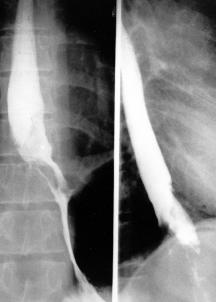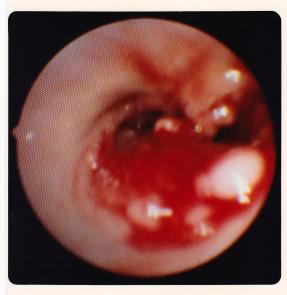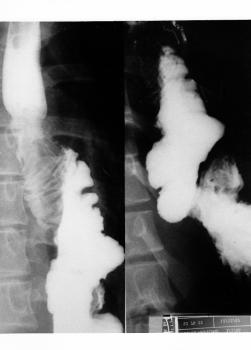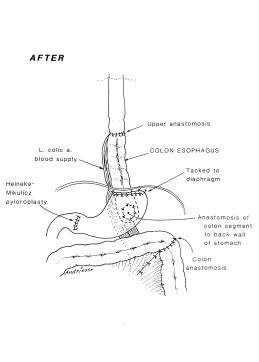Hendren Wilms Tumor Patient #3
This 3-year-old boy was hospitalized December 1978 with a mass palpable in both right and left flanks. Intravenous pyelogram (IVP) was consistent with bilateral Wilms’ tumors. Chest films were normal.
Angiography showed both kidneys displaced by a mass but with relatively intact renal parenchyma. Decision was made to treat patient with preoperative chemotherapy with hope to save most of each kidney if possible during surgery later.
As seen in the following six figures, there was progressive shrinkage of the two tumors.
Fig. 1. Intravenous Pyelogram (Select Image for High-quality Version). IVP December 1978 consistent with bilateral Wilms’ tumors. Lungs clear on chest film.
Fig. 2. Aortagram (Select Image for High-quality Version). Aortography on hospital day 3. Both main renal arteries are normal although displaced.
Fig. 3. Angiograph (Select Image for High-quality Version). Left kidney pushed upward, and lying transversely, by the tumor below it. Note intact parenchyma.
Fig. 4. Intravenous Pyelogram (Select Image for High-quality Version). IVP after 1 month of chemotherapy with Actinomycin D and Vincristine. Masses smaller.
Fig. 5. Intravenous Pyelogram (Select Image for High-quality Version). IVP after 2 months of chemotherapy. Almost normal calyceal architecture on the left side. Mass behind left kidney 2 inches (5.08 cm) in diameter. Mass at upper pole of the right kidney 5 inches (12.7 cm) in diameter.
Fig. 6. Angiograph (Select Image for High-quality Version). Selective renal angiogram, left side before surgery. About 2/3's of parenchyma judged to be normal.
Surgical excision was performed in March 1979, 2.5 months after admission. Under anesthesia during preliminary cystoscopy ureteral catheters were passed up to each kidney to allow irrigation of saline up to each after removal of the tumor to check for calyceal leaks. The ureteral catheters were taped to an inlying Foley catheter to keep them in place.
A long transverse upper abdominal “frown” incision was made from one flank to the other in supine position. There was no tumor visible or palpable except in the flanks. The left side was approached first, reflecting the left colon downward. Gerota’s capsule was opened, staying free from the tumor, then about the size of a squash ball. It lay posteriorly at the renal hilum. The anterior aspect of the kidney and both upper and lower poles were free. All vessels were isolated. The kidney was packed in ice to cool it. The vessels were then cross clamped and it was cooled further to lengthen the ischemic time which would be safe. The tumor was then dissected from the normal kidney with a 5 mm. margin of normal renal parenchyma with the specimen. Scissors were used for this dissection, guiding the plane of dissection with the palpating left hand fingers. All transected renal vascular branches were clamped and over sewn.
Fig. 7. Left Kidney. The posterior side of the left kidney with the tumor remarkably smaller than before chemotherapy.
Fig. 8. Defect in Left Kidney. After removing the tumor by scissor dissection. Clamp time for the renal vessels had been 17 minutes.
An assistant irrigated the left ureteral catheter to demonstrate two opening to be closed in the renal collecting system. An omental patch was taken from the greater curvature of the stomach to suture over the renal defect. The kidney was then put back into Gerota’s capsule. The flank was drained.
The right side was then exposed, reflecting the hepatic flexure of colon medially. The tumor was much larger, 5 inches (12.7 cm) in diameter and occupying the upper 2/3 rds of the kidney. An identical procedure was performed, after renal cooling. Curiously the cross clamp time of ischemia perchance was 17 minutes, the same as the left had been. Omentum was not as generous on the right. A flap of Gerota’s fascia and adjacent fat was used instead, as a pedicle flap to cover the renal open surface.
Fig. 9. Right Kidney. Kidney mobilized and draped, to cool and clamp. Tumor occupied the entire upper kidney.
Fig. 10. Tumor Removed. Renal pelvis to close in center of kidney. A pedicle flap of Gerota’s covered the defect.
Nitroprusside hypotension to 65 mm. Hg. Intraoperatively helped reduce blood loss during this 6-hour operation.
Fig. 11. Retrograde Injection of Ureteral Catheters. One week post-operatively demonstrating no leaks from right hemi kidney or nearly normal left kidney.
Fig. 12. Intravenous Pyelogram. IVP two weeks post-operatively demonstrating good function on both sides.
In January 1980, at age 4 years the patient had an episode of intestinal obstruction from an adhesion across the terminal ileum.
Chemotherapy was continued for a total of two years. Radiation was never given because there was no suspicion of residual tumors.
The pathology examination described nephroblastoma with focal rhabdomyomatous differentiation.
At age 11 years he was in a motor scooter accident and had head trauma, requiring 3 months of hospitalization.
At age 13 years he was evaluated for endocrinopathy after excessive weight gain. He complained also of panic attacks. No endocrine problem was identified.
























